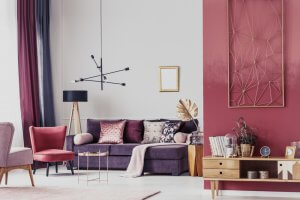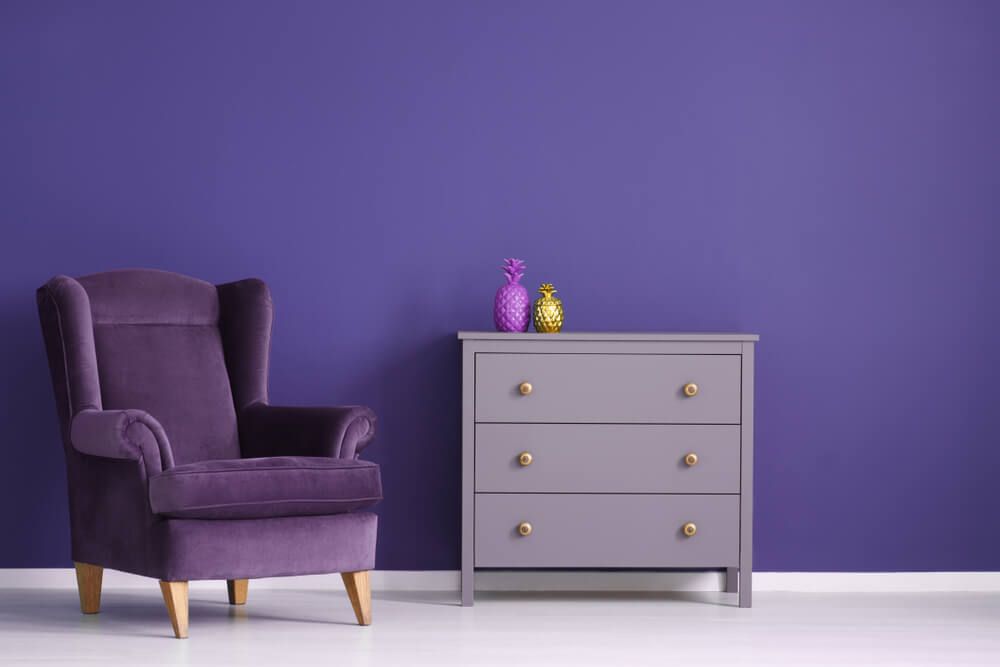Dare to Go Purple: Purple Rooms

Linked with royalty and sacredness, as well as other positive traits, purple is the decor choice for special settings. If you’re thinking about creating a purple room, check out today’s post.
What does purple symbolize?
Maybe you always liked purple… or maybe you just saw it randomly in a picture and found inspiration for your room. Whatever the case might be, digging deeper into its symbolism is never a bad idea.
Purple (or violet) is a color that falls between warm and cool tones because it’s composed of red and blue. It features the characteristics of both sides, which is helpful but ambiguous.
First things first, if you want to decorate a room purple, be aware of its many positive qualities because it’s a highly regarded color in spirituality. This explains why it’s considered sacred in various religions. For example, Catholic priests dress in purple during important events like Advent or Lent.
From an emotional perspective, purple is believed to have profound impacts on the mind and many people use it to calm anxieties. People say that it transmits peace, fights fears and shrinks obsessions. In light of its emotional qualities, purple could be a great choice for a room.
People link purple to creativity, sensitivity, mystery, fantasy, introspection… Even more reason to choose it for your room!
But of course, nothing is perfect; purple can lead to interior conflict, sadness, agony, and depression. To prevent these outcomes, you can always use it with other colors like white.
Purple is a very elegant color and in a lighter shade, it evokes delicateness. So, be wary of creating an overly sweet setting.
If you’re interested in Feng Shui, the practice attributes purple with powers to transform energy and painful situations into something positive and calming. Naturally, people use it for rooms: it calms insomnia, pacifies and reduces emotional pain.
Decorate your room purple
One tip for using purpose is that the darkest shades look best on small objects, and not walls or big furniture. In other words, choose it for details.
Otherwise, using a very strong, dark color will absorb too much light, making the room look smaller and might even feel oppressive at night.
As we mentioned before, you can pair it with a lighter color, like white, which can brighten up the space. Other colors that look great with purple are turquoise, granny smith green, like and respective complementary colors.
You could have a purple room and follow different kinds of decor. For example, for a shabby chic look, try keeping things lavender or light violet; for vintage, look for an even lighter tone.
If you’re a fan of the contemporary style, choose a strong, bold purple. But if you’re looking for something more elegant and sophisticated, go with a dark shade and use it with wooden furniture.

Purple details in a room
Maybe you’re not up for an entirely purple room, but you love the color and the effects that it has on decor. So, you could try starting out with purple details or accessories.
For example, set up a room with white walls and bedding along with a purple headboard, curtains, and lamps. You could also use different shades of pink and purple; together with white, they’ll create a very elegant and delicate decor.
You can add more purple items one at a time. A great idea is just painting one wall in purple and the rest in white. Match it with pillows in the same shade and hang up a picture on the opposite wall that has the color, too! And don’t forget some springs of lavender in a beautiful vase!